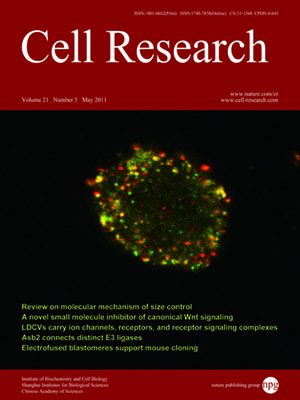Volume 21 Issue 5, May 2011: 835-848
ORIGINAL ARTICLES
Rice RING protein OsBBI1 with E3 ligase activity confers broad-spectrum resistance against Magnaporthe oryzae by modifying the cell wall defence
Wei Li1,*, Sihui Zhong2,*, Guojun Li1, Qun Li2, Bizeng Mao1, Yiwen Deng2, Huijuan Zhang1, Longjun Zeng2, Fengming Song1 and Zuhua He1,2
1National Key Laboratory for Rice Biology, Institute of Biotechnology, Zhejiang University, Hangzhou 310029, China
2National Key Laboratory of Plant Molecular Genetics, Institute of Plant Physiology and Ecology, Shanghai Institutes for Biological Sciences, Chinese Academy of Sciences, Shanghai 200032, China
Correspondence: Zuhua He, Fengming Song,(zhhe@sibs.ac.cn; fmsong@zju.edu.cn)
Emerging evidence suggests that E3 ligases play critical roles in diverse biological processes, including innate immune responses in plants. However, the mechanism of the E3 ligase involvement in plant innate immunity is unclear. We report that a rice gene,
OsBBI1, encoding a RING finger protein with E3 ligase activity, mediates broad-spectrum disease resistance. The expression of
OsBBI1 was induced by rice blast fungus
Magnaporthe oryzae, as well as chemical inducers, benzothiadiazole and salicylic acid. Biochemical analysis revealed that OsBBI1 protein possesses E3 ubiquitin ligase activity
in vitro. Genetic analysis revealed that the loss of
OsBBI1 function in a
Tos17-insertion line increased susceptibility, while the overexpression of
OsBBI1 in transgenic plants conferred enhanced resistance to multiple races of
M. oryzae. This indicates that OsBBI1 modulates broad-spectrum resistance against the blast fungus. The
OsBBI1-overexpressing plants showed higher levels of H
2O
2 accumulation in cells and higher levels of phenolic compounds and cross-linking of proteins in cell walls at infection sites by
M. oryzae compared with wild-type (WT) plants. The cell walls were thicker in the
OsBBI1-overexpressing plants and thinner in the mutant plants than in the WT plants. Our results suggest that OsBBI1 modulates broad-spectrum resistance to blast fungus by modifying cell wall defence responses. The functional characterization of OsBBI1 provides insight into the E3 ligase-mediated innate immunity, and a practical tool for constructing broad-spectrum resistance against the most destructive disease in rice.
Cell Research (2011) 21:835-848. doi:10.1038/cr.2011.4; published online 11 January 2011
FULL TEXT | PDF
Browse 2111


